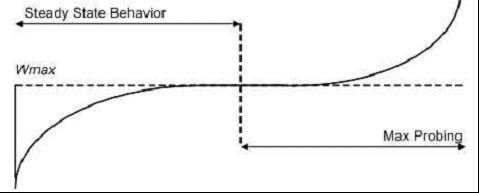浅谈tcp cubic拥塞算法以及优化建议
来源:互联网 发布:广州公交线路查询软件 编辑:程序博客网 时间:2024/06/12 00:17
1. tcp cubic数学模型
CUBIC在设计上简化了BIC-TCP的窗口调整算法,在BIC-TCP的窗口调整中会出现一个凹和凸(这里的凹和凸指的是数学意义上的凹和凸,凹函数/凸函数)的增长曲线,CUBIC使用了一个三次函数(即一个立方函数),在三次函数曲线中同样存在一个凹和凸的部分,该曲线形状和BIC-TCP的曲线图十分相似,于是该部分取代BIC-TCP的增长曲线。另外,CUBIC中最关键的点在于它的窗口增长函数仅仅取决于连续的两次拥塞事件的时间间隔值,从而窗口增长完全独立于网络的时延RTT,之前讲述过的HSTCP存在严重的RTT不公平性,而CUBIC的RTT独立性质使得CUBIC能够在多条共享瓶颈链路的TCP连接之间保持良好的RRTT公平性。
来看下具体细节:当某次拥塞事件发生时,Wmax设置为此时发生拥塞时的窗口值,然后把窗口进行乘法减小,乘法减小因子设为β,当从快速恢复阶段退出然后进入到拥塞避免阶段,此时CUBIC的窗口增长开始按照“凹”式增长曲线进行增长,该过程一直持续直到窗口再次增长到Wmax,紧接着,该函数转入“凸”式增长阶段。该方式的增长可以使得窗口一直维持在Wmax附近,从而可以达到网络带宽的高利用率和协议本身的稳定性。

窗口的增长函数如下:
W(t) = C * (t-K)3 + Wmax, 其中C和β为常量。
t为当前时间距上一次窗口减小的时间差,而K就代表该函数从W增长到Wmax的时间周期,![]() 。
。
当收到ACK后,CUBIC计算利用该算法计算下一个RTT内的窗口增长速度,即计算W(t+RTT),该值将作为cwnd的目标值,根据cwnd的大小,CUBIC将进入三种不同模式,如果cwnd会小于在标准TCP下经过上次拥塞之后的时刻t窗口将会达到的值(该值是通过标准TCP的窗口增长函数计算出来的),那么CUBIC就处于标准TCP模式,如果小于Wmax,那么位于凹阶段的,如果大于Wmax,那么处于凸阶段。
上述具体的论文可以参考:CUBIC: A New TCP-Friendly High-Speed TCP Variant2. tcp cubic 内核源代码调用逻辑
CUBIC整体架构调用的逻辑如下:
1. 连接每收到一个ack,则调用tcp_ack
2. tcp_ack会调用bictcp_acked,用来更新cnt和delayed_ack(用来消除delay包的影响)
3. tcp_ack会调用bictcp_cong_avoid,这是分两种情况:
(1)snd_cwnd小于慢启动阈值,处于慢启动阶段,则调用tcp_slow_start
(2)snd_cwnd大于慢启动阈值,处于拥塞避免阶段,则调用bictcp_update来更新bictcp,再调用tcp_cong_avoid_ai
4. tcp_ack中如果检测到丢包,进入拥塞处理阶段,则调用bictcp_recalc_ssthresh来更新慢启动阈值
5. tcp_ack中完成丢包重传后,退出拥塞处理阶段,则调用bictcp_undo_cwnd来更新snd_cwnd
快速重传:tcp_ack中的丢包检测,即检测到连续3个重复ACK。
快速恢复:bictcp_undo_cwnd,直接把snd_cwnd更新为max(snd_cwnd,last_max_cwnd),和掉包前相差不大。
3:代码解读
/* * TCP CUBIC: Binary Increase Congestion control for TCP v2.3 * Home page: * http://netsrv.csc.ncsu.edu/twiki/bin/view/Main/BIC * This is from the implementation of CUBIC TCP in * Sangtae Ha, Injong Rhee and Lisong Xu, * "CUBIC: A New TCP-Friendly High-Speed TCP Variant" * in ACM SIGOPS Operating System Review, July 2008. * Available from: * http://netsrv.csc.ncsu.edu/export/cubic_a_new_tcp_2008.pdf * * CUBIC integrates a new slow start algorithm, called HyStart. * The details of HyStart are presented in * Sangtae Ha and Injong Rhee, * "Taming the Elephants: New TCP Slow Start", NCSU TechReport 2008. * Available from: * http://netsrv.csc.ncsu.edu/export/hystart_techreport_2008.pdf * * All testing results are available from: * http://netsrv.csc.ncsu.edu/wiki/index.php/TCP_Testing * * Unless CUBIC is enabled and congestion window is large * this behaves the same as the original Reno. */#include <linux/mm.h>#include <linux/module.h>#include <linux/math64.h>#include <net/tcp.h>#define BICTCP_BETA_SCALE 1024/* Scale factor beta calculation * max_cwnd = snd_cwnd * beta */#defineBICTCP_HZ10/* BIC HZ 2^10 = 1024 *//* Two methods of hybrid slow start */#define HYSTART_ACK_TRAIN0x1#define HYSTART_DELAY0x2/* Number of delay samples for detecting the increase of delay */#define HYSTART_MIN_SAMPLES8#define HYSTART_DELAY_MIN(2U<<3)#define HYSTART_DELAY_MAX(16U<<3)#define HYSTART_DELAY_THRESH(x)clamp(x, HYSTART_DELAY_MIN, HYSTART_DELAY_MAX)static int fast_convergence __read_mostly = 1;static int beta __read_mostly = 717;/* = 717/1024 (BICTCP_BETA_SCALE) */static int initial_ssthresh __read_mostly;//bic_scale就是paper中三次方系数C的1024倍缩放值//MODULE_PARM_DESC(bic_scale, "scale (scaled by 1024) value for bic function (bic_scale/1024)");static int bic_scale __read_mostly = 41;static int tcp_friendliness __read_mostly = 1;static int hystart __read_mostly = 1;static int hystart_detect __read_mostly = HYSTART_ACK_TRAIN | HYSTART_DELAY;static int hystart_low_window __read_mostly = 16;static u32 cube_rtt_scale __read_mostly;static u32 beta_scale __read_mostly;static u64 cube_factor __read_mostly;/* Note parameters that are used for precomputing scale factors are read-only */module_param(fast_convergence, int, 0644);MODULE_PARM_DESC(fast_convergence, "turn on/off fast convergence");module_param(beta, int, 0644);MODULE_PARM_DESC(beta, "beta for multiplicative increase");module_param(initial_ssthresh, int, 0644);MODULE_PARM_DESC(initial_ssthresh, "initial value of slow start threshold");module_param(bic_scale, int, 0444);MODULE_PARM_DESC(bic_scale, "scale (scaled by 1024) value for bic function (bic_scale/1024)");module_param(tcp_friendliness, int, 0644);MODULE_PARM_DESC(tcp_friendliness, "turn on/off tcp friendliness");module_param(hystart, int, 0644);MODULE_PARM_DESC(hystart, "turn on/off hybrid slow start algorithm");module_param(hystart_detect, int, 0644);MODULE_PARM_DESC(hystart_detect, "hyrbrid slow start detection mechanisms" " 1: packet-train 2: delay 3: both packet-train and delay");module_param(hystart_low_window, int, 0644);MODULE_PARM_DESC(hystart_low_window, "lower bound cwnd for hybrid slow start");/* BIC TCP Parameters */struct bictcp {u32cnt;/* increase cwnd by 1 after ACKs */u32 last_max_cwnd;/* last maximum snd_cwnd *///两个重要的count值://第一个是tcp_sock->snd_cwnd_cnt,表示在当前的拥塞窗口中已经//发送(经过对方ack包确认)的数据段的个数,//而第二个是bictcp->cnt,它是cubic拥塞算法的核心,//主要用来控制在拥塞避免状态的时候,什么时候才能增大拥塞窗口,//具体实现是通过比较cnt和snd_cwnd_cnt,来决定是否增大拥塞窗口,u32loss_cwnd;/* congestion window at last loss */u32last_cwnd;/* the last snd_cwnd */u32last_time;/* time when updated last_cwnd */u32bic_origin_point;/* origin point of bic function */u32bic_K;/* time to origin point from the beginning of the current epoch */u32delay_min;/* min delay */u32epoch_start;/* beginning of an epoch */u32ack_cnt;/* number of acks */u32tcp_cwnd;/* estimated tcp cwnd */#define ACK_RATIO_SHIFT4u16delayed_ack;/* estimate the ratio of Packets/ACKs << 4 */u8sample_cnt;/* number of samples to decide curr_rtt */u8found;/* the exit point is found? */u32round_start;/* beginning of each round */u32end_seq;/* end_seq of the round */u32last_jiffies;/* last time when the ACK spacing is close */u32curr_rtt;/* the minimum rtt of current round */};static inline void bictcp_reset(struct bictcp *ca){ca->cnt = 0;ca->last_max_cwnd = 0;ca->loss_cwnd = 0;ca->last_cwnd = 0;ca->last_time = 0;ca->bic_origin_point = 0;ca->bic_K = 0;ca->delay_min = 0;ca->epoch_start = 0;ca->delayed_ack = 2 << ACK_RATIO_SHIFT;ca->ack_cnt = 0;ca->tcp_cwnd = 0;ca->found = 0;}static inline void bictcp_hystart_reset(struct sock *sk){struct tcp_sock *tp = tcp_sk(sk);struct bictcp *ca = inet_csk_ca(sk);ca->round_start = ca->last_jiffies = jiffies;ca->end_seq = tp->snd_nxt;ca->curr_rtt = 0;ca->sample_cnt = 0;}static void bictcp_init(struct sock *sk){bictcp_reset(inet_csk_ca(sk));if (hystart)bictcp_hystart_reset(sk);if (!hystart && initial_ssthresh)tcp_sk(sk)->snd_ssthresh = initial_ssthresh;}/* calculate the cubic root of x using a table lookup followed by one * Newton-Raphson iteration. * Avg err ~= 0.195% */static u32 cubic_root(u64 a){u32 x, b, shift;/* * cbrt(x) MSB values for x MSB values in [0..63]. * Precomputed then refined by hand - Willy Tarreau * * For x in [0..63], * v = cbrt(x << 18) - 1 * cbrt(x) = (v[x] + 10) >> 6 */static const u8 v[] = {/* 0x00 */ 0, 54, 54, 54, 118, 118, 118, 118,/* 0x08 */ 123, 129, 134, 138, 143, 147, 151, 156,/* 0x10 */ 157, 161, 164, 168, 170, 173, 176, 179,/* 0x18 */ 181, 185, 187, 190, 192, 194, 197, 199,/* 0x20 */ 200, 202, 204, 206, 209, 211, 213, 215,/* 0x28 */ 217, 219, 221, 222, 224, 225, 227, 229,/* 0x30 */ 231, 232, 234, 236, 237, 239, 240, 242,/* 0x38 */ 244, 245, 246, 248, 250, 251, 252, 254,};b = fls64(a);if (b < 7) {/* a in [0..63] */return ((u32)v[(u32)a] + 35) >> 6;}b = ((b * 84) >> 8) - 1;shift = (a >> (b * 3));x = ((u32)(((u32)v[shift] + 10) << b)) >> 6;/* * Newton-Raphson iteration * 2 * x = ( 2 * x + a / x ) / 3 * k+1 k k */x = (2 * x + (u32)div64_u64(a, (u64)x * (u64)(x - 1)));x = ((x * 341) >> 10);return x;}/*函数关键点1. 我们最终要得到的是ca->cnt,用来控制snd_cwnd的增长。2. ca->cnt的值,是根据cwnd和w( t + after ) 的大小来判断的。w( t + after )即bic_target,它表示我们预期的在经过after时间后的snd_cwnd。如果此时cwnd < w( t + after ),那么我们就快速增加窗口,达到预期目标。如果cwnd > w( t + after ),那说明我们已经增加过快了,需要降速了,这样才能达到预期目标。 cwnd / (bic_target - cwnd ) // bic_target > cwnd cnt = 100 * cwnd // bic_target < cwnd 3. cwnd是传入的参数,已知。现在我们只需要计算bic_target。而根据Cubic的窗口增长函数:W(t) = C(t - K)^3 + Wmax,我们要计算时间( 当前 + after ),以及时间K。时间K即bic_K,表示函数值为Wmax所对应的时间。通过代码可以发现,after为min RTT,即连接的传播时延。*//* * Compute congestion window to use. */static inline void bictcp_update(struct bictcp *ca, u32 cwnd){u64 offs;/* 时间差,| t - K | */ u32 delta, t, bic_target, max_cnt;/* delta是cwnd差,bic_target是预测值,t为预测时间 */ ca->ack_cnt++;/* count the number of ACKs */if (ca->last_cwnd == cwnd && (s32)(tcp_time_stamp - ca->last_time) <= HZ / 32)return;ca->last_cwnd = cwnd;ca->last_time = tcp_time_stamp;if (ca->epoch_start == 0) {ca->epoch_start = tcp_time_stamp;/* record the beginning of an epoch */ca->ack_cnt = 1;/* start counting */ca->tcp_cwnd = cwnd;/* syn with cubic */ /* 取max(last_max_cwnd , cwnd)作为当前Wmax */ if (ca->last_max_cwnd <= cwnd) {ca->bic_K = 0;ca->bic_origin_point = cwnd;} else {/* Compute new K based on * (wmax-cwnd) * (srtt>>3 / HZ) / c * 2^(3*bictcp_HZ) */ca->bic_K = cubic_root(cube_factor * (ca->last_max_cwnd - cwnd));ca->bic_origin_point = ca->last_max_cwnd;}}/* cubic function - calc*//* calculate c * time^3 / rtt, * while considering overflow in calculation of time^3 * (so time^3 is done by using 64 bit) * and without the support of division of 64bit numbers * (so all divisions are done by using 32 bit) * also NOTE the unit of those veriables * time = (t - K) / 2^bictcp_HZ * c = bic_scale >> 10 * rtt = (srtt >> 3) / HZ * !!! The following code does not have overflow problems, * if the cwnd < 1 million packets !!! *//* change the unit from HZ to bictcp_HZ */t = ((tcp_time_stamp + (ca->delay_min>>3) - ca->epoch_start) << BICTCP_HZ) / HZ; /* 求| t - bic_K | */ if (t < ca->bic_K)/* 还未达到Wmax */ offs = ca->bic_K - t;elseoffs = t - ca->bic_K; //此时已经超过Wmax/* c/rtt * (t-K)^3 */ /* 计算delta =| W(t) - W(bic_K) | * cube_rtt_scale = (bic_scale * 10) = c / srtt * 2^10,c/srtt = 0.4 */delta = (cube_rtt_scale * offs * offs * offs) >> (10+3*BICTCP_HZ);if (t < ca->bic_K) /* below origin*/bic_target = ca->bic_origin_point - delta;else /* above origin*/bic_target = ca->bic_origin_point + delta;/* cubic function - calc bictcp_cnt /* 计算bic_target,即预测cwnd */if (bic_target > cwnd) { /* 相差越多,增长越快,这就是函数形状由来 */ca->cnt = cwnd / (bic_target - cwnd);} else {ca->cnt = 100 * cwnd; /* very small increment 目前cwnd已经超出预期了,应该降速*/}/* TCP Friendly /* TCP Friendly —如果cubic比RENO慢,则提升cwnd增长速度,即减小cnt * 以上次丢包以后的时间t算起,每次RTT增长 3B / ( 2 - B),那么可以得到 * 采用RENO算法的cwnd。 * cwnd (RENO) = cwnd + 3B / (2 - B) * ack_cnt / cwnd * B为乘性减少因子,在此算法中为0.3 */if (tcp_friendliness) {u32 scale = beta_scale;delta = (cwnd * scale) >> 3;while (ca->ack_cnt > delta) {/* update tcp cwnd */ca->ack_cnt -= delta;ca->tcp_cwnd++;}if (ca->tcp_cwnd > cwnd){/* if bic is slower than tcp */delta = ca->tcp_cwnd - cwnd;max_cnt = cwnd / delta;if (ca->cnt > max_cnt)ca->cnt = max_cnt;}}ca->cnt = (ca->cnt << ACK_RATIO_SHIFT) / ca->delayed_ack;//做了一个比较直接的delay_ack的控制 //ratio = (15*ratio + sample) / 16 这里ca-delayed_ack由if (ca->cnt == 0)/* cannot be zero */ca->cnt = 1;/* 此时代表cwnd远小于bic_target,增长速度最大 */ }static void bictcp_cong_avoid(struct sock *sk, u32 ack, u32 in_flight){struct tcp_sock *tp = tcp_sk(sk);struct bictcp *ca = inet_csk_ca(sk); //判断发送拥塞窗口是否到达限制,如果到达限制则直接返回if (!tcp_is_cwnd_limited(sk, in_flight))return;if (tp->snd_cwnd <= tp->snd_ssthresh) {if (hystart && after(ack, ca->end_seq))bictcp_hystart_reset(sk);tcp_slow_start(tp);//进入slow start状态} else {bictcp_update(ca, tp->snd_cwnd);tcp_cong_avoid_ai(tp, ca->cnt);//然后进入拥塞避免,更新tcp_sock->snd_cwnd_cnt}}//做了两件事:重赋值last_max_cwnd、返回新的慢启动阈值static u32 bictcp_recalc_ssthresh(struct sock *sk){const struct tcp_sock *tp = tcp_sk(sk);struct bictcp *ca = inet_csk_ca(sk);ca->epoch_start = 0;/* end of epoch *//* Wmax and fast convergence */ //当一个新的TCP流加入到网络, //网络中已有TCP流需要放弃自己带宽, //给新的TCP流提供一定的上升空间。 //为提高已有TCP流所释放的带宽而引入快速收敛机制。if (tp->snd_cwnd < ca->last_max_cwnd && fast_convergence) //表示已有TCP流所经历的饱和点因为可用带宽改变而正在降低。 //然后,通过进一步降低Wmax让已有流释放更多带宽。 //这种行为有效地延长已有流增大其窗口的时间, //因为降低后的Wmax强制已有流更早进入平稳状态。 //这允许新流有更多的时间来赶上其窗口尺寸。ca->last_max_cwnd = (tp->snd_cwnd * (BICTCP_BETA_SCALE + beta))/ (2 * BICTCP_BETA_SCALE);//last_max_cwnd = 0.9 * snd_cwndelseca->last_max_cwnd = tp->snd_cwnd;ca->loss_cwnd = tp->snd_cwnd; //修改snd_ssthresh,即max(0.7*snd_cwnd,2)return max((tp->snd_cwnd * beta) / BICTCP_BETA_SCALE, 2U);}//快速恢复:直接把snd_cwnd更新为max(snd_cwnd,last_max_cwnd),和掉包前相差不大static u32 bictcp_undo_cwnd(struct sock *sk){struct bictcp *ca = inet_csk_ca(sk);return max(tcp_sk(sk)->snd_cwnd, ca->last_max_cwnd);}static void bictcp_state(struct sock *sk, u8 new_state){if (new_state == TCP_CA_Loss) {bictcp_reset(inet_csk_ca(sk));bictcp_hystart_reset(sk);}}static void hystart_update(struct sock *sk, u32 delay){struct tcp_sock *tp = tcp_sk(sk);struct bictcp *ca = inet_csk_ca(sk);if (!(ca->found & hystart_detect)) {u32 curr_jiffies = jiffies;/* first detection parameter - ack-train detection */if (curr_jiffies - ca->last_jiffies <= msecs_to_jiffies(2)) {ca->last_jiffies = curr_jiffies;if (curr_jiffies - ca->round_start >= ca->delay_min>>4)ca->found |= HYSTART_ACK_TRAIN;}/* obtain the minimum delay of more than sampling packets */if (ca->sample_cnt < HYSTART_MIN_SAMPLES) {if (ca->curr_rtt == 0 || ca->curr_rtt > delay)ca->curr_rtt = delay;ca->sample_cnt++;} else {if (ca->curr_rtt > ca->delay_min + HYSTART_DELAY_THRESH(ca->delay_min>>4))ca->found |= HYSTART_DELAY;}/* * Either one of two conditions are met, * we exit from slow start immediately. */if (ca->found & hystart_detect)tp->snd_ssthresh = tp->snd_cwnd;}}/* Track delayed acknowledgment ratio using sliding window * ratio = (15*ratio + sample) / 16 *///跟踪延迟确认在滑动窗口的比例,主要考虑正常和丢包的时候,是一个参考值//根据下面这个函数。化简得 delayed_ack = 15/16*delayed_ack + cnt;//由于 ratio = delayed_ack/ 16; 16*ration = 15*ration+cnt//所以 ratio = 15/16 * ratio + cnt / 16;static void bictcp_acked(struct sock *sk, u32 cnt, s32 rtt_us){const struct inet_connection_sock *icsk = inet_csk(sk);const struct tcp_sock *tp = tcp_sk(sk);struct bictcp *ca = inet_csk_ca(sk);u32 delay;if (icsk->icsk_ca_state == TCP_CA_Open) {cnt -= ca->delayed_ack >> ACK_RATIO_SHIFT;ca->delayed_ack += cnt;}/* Some calls are for duplicates without timetamps */if (rtt_us < 0)return;/* Discard delay samples right after fast recovery */if ((s32)(tcp_time_stamp - ca->epoch_start) < HZ)return;delay = usecs_to_jiffies(rtt_us) << 3;if (delay == 0)delay = 1;/* first time call or link delay decreases */if (ca->delay_min == 0 || ca->delay_min > delay)ca->delay_min = delay;/* hystart triggers when cwnd is larger than some threshold */if (hystart && tp->snd_cwnd <= tp->snd_ssthresh && tp->snd_cwnd >= hystart_low_window)hystart_update(sk, delay);}static struct tcp_congestion_ops cubictcp = {.init= bictcp_init,.ssthresh= bictcp_recalc_ssthresh,.cong_avoid= bictcp_cong_avoid,.set_state= bictcp_state,.undo_cwnd= bictcp_undo_cwnd,.pkts_acked = bictcp_acked,.owner= THIS_MODULE,.name= "cubic",};static int __init cubictcp_register(void){BUILD_BUG_ON(sizeof(struct bictcp) > ICSK_CA_PRIV_SIZE);/* Precompute a bunch of the scaling factors that are used per-packet * based on SRTT of 100ms */ //beta_scale == 8*(1024 + 717) / 3 / (1024 -717 ),大约为15beta_scale = 8*(BICTCP_BETA_SCALE+beta)/ 3 / (BICTCP_BETA_SCALE - beta); //cube_rtt_scale cube_rtt_scale是bic_scale/RTT, 这里rtt=100ms=0.1scube_rtt_scale = (bic_scale * 10);/* 1024*c/rtt *//* calculate the "K" for (wmax-cwnd) = c/rtt * K^3 * so K = cubic_root( (wmax-cwnd)*rtt/c ) * the unit of K is bictcp_HZ=2^10, not HZ * * c = bic_scale >> 10 * rtt = 100ms * * the following code has been designed and tested for * cwnd < 1 million packets * RTT < 100 seconds * HZ < 1,000,00 (corresponding to 10 nano-second) *//* 1/c * 2^2*bictcp_HZ * srtt */ //通过bic_K和paper中的公式对比,可以知道cube_factor就是1/(C/RTT) //具体需要参考算法实现,以及这里的30是开根号cube_factor = 1ull << (10+3*BICTCP_HZ); /* 2^40 *//* divide by bic_scale and by constant Srtt (100ms) */do_div(cube_factor, bic_scale * 10);return tcp_register_congestion_control(&cubictcp);}static void __exit cubictcp_unregister(void){tcp_unregister_congestion_control(&cubictcp);}module_init(cubictcp_register);module_exit(cubictcp_unregister);MODULE_AUTHOR("Sangtae Ha, Stephen Hemminger");MODULE_LICENSE("GPL");MODULE_DESCRIPTION("CUBIC TCP");MODULE_VERSION("2.3"); 4:调整tcp参数说明
所有的参数是全局从symbol读取,可以设置。
fast_convergence = 0 开启后快速收敛,丢包后略小的W-max,可以关闭。
tcp_friendliness = 1 默认参数,始终开启, 开启后实际上保证了per RTT内的增长率。
我们知道RENO采用AIMD,其中a=1,B=0.5。在某些条件下,在同一时间点,
cwnd( Cubic ) < cwnd( Reno ),这说明Cubic此时比Reno慢。友好性函数在这种情况下被调用,用来加快
连接的cwnd的增长速度,即减小cnt。
那么怎么算采用Reno时的cwnd呢?以上次丢包以后的时间t算起,每次RTT增长3B / ( 2 - B),那么就和采用
Reno有着相同的平均cwnd,即从效果上等同于采用Reno。
beta=717 可以设置的更大(beta/1024)控制丢包后的窗口大小,早期值为819
BICTCP_HZ=10 对于HZ>=1000可以适当调整这个值,来让K有高的精度, 影响不大
hystart = 1 保持默认开启,快速退出慢启动,使用三次方增长曲线
bic_scale = 41 系数C的1024倍,C越大K越小,可以适当增大这个数值
其他:
代码中cube_rtt_scale和cube_factor使用了RTT=100ms来计算,可以适当减小这个数值
更小的RTT意味着
- cube_rtt_scale更大,更高的增长率系数C
- cube_factor更小, 更小的K值
- 浅谈tcp cubic拥塞算法以及优化建议
- linux kernel tcp拥塞处理之cubic算法
- TCP拥塞控制算法 — CUBIC的补丁(一)
- TCP拥塞控制算法 — CUBIC的补丁(二)
- TCP拥塞控制算法 — CUBIC的补丁(三)
- TCP拥塞控制算法 — CUBIC的补丁(四)
- TCP拥塞控制算法 — CUBIC的补丁(五)
- TCP拥塞控制算法 — CUBIC的补丁(六)
- TCP拥塞控制算法 — CUBIC的补丁(七)
- linux kernel tcp拥塞处理之cubic算法
- TCP拥塞控制算法-从BIC到CUBIC
- TCP拥塞控制算法纵横谈-BBR vs Reno/CUBIC
- 从TCP拥塞本质看BBR算法及其收敛性(附CUBIC的改进/NCL机制)
- tcp cubic 算法分析注释
- TCP拥塞控制算法
- TCP拥塞控制算法
- TCP拥塞控制算法
- tcp的拥塞算法
- HDU-6150 Vertex Cover(构造)
- zoj 3233 Lucky Number(容斥原理)
- python中join()函数详解
- Oracle导入导出
- 使用Handler实现打地鼠(下)
- 浅谈tcp cubic拥塞算法以及优化建议
- 203. Remove Linked List Elements
- django学习笔记(二)——mysql数据库
- 整理出来前端面试题 js篇
- 类,对象,属性,方法是什么
- 单片机汇编代码分析示例
- 罗素说理想与历程—幸福心灵的获取
- [kmp] hdu6153 A Secret
- [LintCode]54.转换字符串到整数


